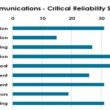Receiver design cited as primary issue in FAA-FCC dispute over 5G deployments near airports
A lack of filtering on older radio altimeters on a fraction of commercial airplanes is the reason potential signaling conflicts may exist, resulting in many flights being grounded or redirected since U.S. wireless carriers launched 5G service on C-band spectrum last month, according to witness testimony to a House subcommittee.
Roberson and Associates President and CEO Dennis Roberson shared these technical insights with members of the House Aviation Subcommittee during a hearing this week that examined the potential safety issues that could occur if new 5G signals conflict with the ability for altimeters to deliver accurate readings. Most of the discussion during the four-hour hearing focused on process issues and the lack of communication between the FCC and the FAA about these potential safety, with Roberson being the lone witness to offer a technical explanation about the matter.
The safety issues associated with 5G deployments on C-band spectrum—3.7 GHz to 3.98 GHz. AT&T and Verizon have taken numerous steps in recent months to allay fears that C-band services could disrupt the readings of airplane altimeters that operate on frequencies at 4.2 GHz to 4.4 GHz. Inaccurate altimeter readings could result in plane crashes, particular for landings conducted in poor-visibility conditions, numerous witnesses testified during the hearing.
At this time, the safety concern appears to be theoretical, Roberson said.
“To my knowledge, there is no instance in the world that there has been a problem with radar altimeters,” Roberson said during the hearing.”
Roberson “there should not be” a safety concern, but acknowledged the potential for one exists. The root problem is the lack of filtering on older altimeters—designed at a time when filtering was unnecessary—as opposed to carriers’ 5G signals causing interference in the 4.2-4.4 GHz band where altimeters are supposed to operate, he said.
“The unfortunate truth is that there is a problem with the design of some of the aviation industry’s older radar altimeters,” Roberson said during the hearing. “The altimeters are supposed to operate in their assigned spectrum bands between 4.2 GHz and 4.4 GHz. When these devices were originally designed, they had very-low-power satellite neighbors. Since the altimeters operate on a radar principle—looking for a signal reflected from the ground—their receivers couldn’t detect the satellite signals.
“This led the altimeter designers to largely ignore their assigned spectrum boundaries. As a result, these receivers are sensitive to transmissions from far outside their assigned band. For decades, this was not an issue. But with new neighbors moving in [carriers offering 5G on C-band spectrum], these old altimeters now have a potential interference problem.”
Roberson, who served as Motorola’s executive vice president and CTO from 1998 to 2004, described the guard band between the carriers’ C-band operations and the altimeter band is historically large, but such spectral separation does not prevent the possibility of signal conflicts when altimeter receivers have little or no filtering.
“It’s a very large cushion,” Roberson said. “It’s really an unprecedented amount of spectrum that separates the 3.7 to 3.8 from the 4.2 to 4.4.”
With proper filtering, airplane altimeters should not be disrupted by the 5G operations in C-band spectrum, Roberson said. But this is not the case for some of the older altimeters, which were manufactured with little or no filtering—an understandable decision at the time, given that only weak satellite signals surrounded the altimeter spectrum until recently.
“Because there was no strong signal in the in vicinity [of the spectrum used by radar altimeters], radar altimeters were designed without any filtering at all, so they saw anything in a very, very large area,” Roberson said. “I do understand why, in an earlier timeframe—since there was no interference outside the band—that the designers chose to eliminate those, because there was no reason for them. Now, there is. And now these altimeters do have a problem.
“But those are old altimeters. My understanding is that new altimeters do have the filtering that is appropriate, and therefore, don’t have a problem.”
Indeed, the FAA has cleared about 90% of the U.S. commercial fleets—including all large airplanes manufactured by Boeing and Airbus, according to reports—to fly under the reduced power levels that AT&T and Verizon are using in the C-band until July. Of the remaining 10% of airplanes, most that have not been cleared by the FAA are regional jets, according to hearing witnesses.
Throughout the lengthy hearing, there were many references made to the lack of communication and coordination between the FCC—the regulatory agency overseeing domestic spectrum and the telecom industry—and the FAA, which regulates the aviation industry. But Roberson suggested that resolving this particular issue with airplane altimeters would have been challenging, even if the relevant agencies communicated very well for years.
One issue is that the FAA had expressed concerns about 5G operations in the C-band since 2015, but the first research study—conducted by RTCA, a non-profit technical commission that works with aviation regulators globally—outlining the concerns in detail was not released until last fall, about a year after the start of the FCC’s C-band auction that generated a record-breaking $81 billion in bids from carriers.
FAA officials repeatedly have stated that they expressed their C-band concerns in a letter that was given to the NTIA, which was supposed to submit it into the FCC proceeding about the C-band. NTIA did not provide the information to the FCC, which was a “process miss,” Roberson said.
However, it would have been difficult for the FCC to act on a high-level statement of concern without researched findings that outlined the issue, according to Roberson.
“The FCC is always looking for technical information that they can act upon,” he said. “While there were considerable worries that were expressed about radar altimeters and operations in general, those weren’t quantified in a way that the FCC could act upon them. This is a process that needs to be improved.”
But even a perfect process would not result in a straightforward solution, because the safety issue revolves around the altimeter receivers—an area that the FCC does not regulate, Roberson said.
“The FCC itself doesn’t regulate receivers; it regulates transmitters,” Roberson said, noting that the receiver-regulation issue has been “under discussion for more than 40 years.”
“For the altimeter designers, they felt free to design an altimeter that looked [for signals] well outside its authorized band—and there’s no legal prohibition [against such receiver designs].”
Finally, Roberson said that he and his team question some findings of the RTCA study that has been the basis of the complaints from the FAA and the aviation industry.
“We have reviewed the RTCA study and do find that there are some significant flaws in the study, where very worst-worst-worst-case assumptions were made,” Roberson said. “It would be very helpful if RTCA and telecommunications engineers would have gotten together in a more timely way to review those studies and hash out the inconsistencies in the way that the study was conducted.”
But Rep. Peter DeFazio (D-Ore.)—chair of the House Committee on Transportation and Infrastructure—said that even the slightest risk is too great in the aviation industry, noting the 2019 crashes of the Boeing 737 MAX aircraft that resulted in 346 deaths.
“Mr. Roberson said, ‘Well, RTCA was based on the worst-worst case,” DeFazio said during the hearing. “Tell that to the families of the 346 people who died on the [two fatal crashes of the Boeing 737 MAX]. That was supposed to be a worst-worst case—very improbable. We don’t run aviation that way in this country.”
“Both the FAA and Boeing said, ‘Well, we followed the rules.’ But 346 died. We changed the damn rules.”
Given the altimeter issue, Rep. Chuy Garcia (D-Ill.) asked CTIA CEO Meredith Attwell Baker whether carriers would be willing to pay some of the costs associated with airlines upgrading their planes’ altimeters.
“I actually think it’s premature to go there,” Baker said. “This hearing seems to presuppose that there’s interference, where we don’t believe there is. I think we need to let the engineers do their job [to make signal-conflict determinations during ongoing studies].”
DeFazio took exception to Baker’s statement.
“There’s another: ‘We don’t think there’s interference?’ Think?” DeFazio said. “We have to be absolutely, 100% to the minus-9 power know—that’s the risk in aviation, one in one billion. And I don’t think we know that yet.”
“I think the telecoms are getting it now, at least Verizon and AT&T. I don’t think CTIA is getting it. I want to make sure that others get it.”
“The RTCA report [addresses] the worst-worst case. Well, that’s what we plan for, the worst-worst case.”
Rep. Rick Larsen (D-Wash.), chair of the Aviation Subcommittee, echoed this sentiment, noting that Baker’s testimony asserted that the RTCA study “applied flawed technology and implausible scenarios.”
Larsen said that the cause of the two Boeing 737 Max crashes “was an implausible scenario, and yet it did happen.”
“We’re in the implausible-scenario business, and that is why there is such a thin safety margin in aviation,” Larsen said during the hearing. “There really aren’t implausible scenarios when it comes to aviation safety.
“When you use that term, that tells me that you don’t get what we’re trying to do.”

















It would be well worth it to the 5G industry to replace these ASAP at their cost. This has the potential to derail major investment